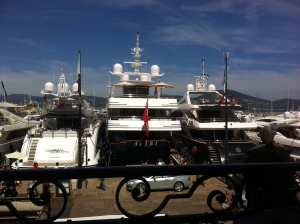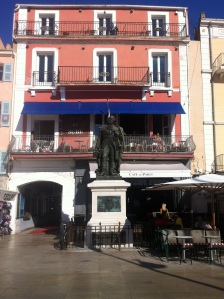Trophée Bailli de Suffren sailing regatta marks the twinning agreement between the ports of Saint-Tropez and Vittoriosa
Back in 1887, Guy de Maupassant was on board of the Bel Ami, as she elegantly entered the sheltered harbour of Saint-Tropez, then an obligatory stop in between Toulon and Antibes.
Maupassant immediately recognized its charm as a harbour town with a huge sense of place, as would many visitors and intellectuals who came after him, who were all allured and captivated by its beauty, a natural shelter to the threatening Mistral winds which can blow violently from the North West.
Saint-Tropez today continues to captivate the imagination of many, and the name itself evokes luxury, the good life and undoubtedly the sweet pleasures of Mediterranean lifestyle. It has become a brand so strong that over five million visitors from all over the world visit the place every year. It is the playground of the élite – actors, artists, Hollywood stars and a handful of wealthy magnates, who choose to hide in the hills and countryside surrounding Saint-Tropez, generously covered with vegetation, pine trees and vineyards.
Saint-Tropez is larger than life. The modest fishing village described by Maupassant in 1887 is the most renowned and one of the most visited towns of France. Its name has been “spinned” by the media worldwide, associated with the fancy lifestyles of royalty and film stars, who have since visited and continue to visit it regularly.
Indeed, Saint-Tropez’s ascent to stardom is irrevocably linked with Brigitte Bardot, who discovered this sleepy fishing village in the early 1960s and who has permanently lived there ever since.
But the history of Saint-Tropez goes far beyond the recent media discovery of the 1960s. Its natural harbour has been a shelter and haven for the Phoenicians, the Romans and the Greeks. Its maritime history and navigation schools have produced some great French mariners. This history has not been forgotten by the Tropezian community of some 5,000 residents who still celebrate every year with great intensity and pride, their most illustrious son: Pierre André de Suffren, Vice-Admiral and Bailiff of the Order of Malta.
The exceptional qualities of the Bailli de Suffren as an Admiral and a strategist were acknowledged by Napoleon himself, who once said of Suffren that he would have been his ‘Lord Nelson’ if only he had lived 30 years earlier! Today, the statue of the “Admiral Satan”, feared by his enemies, stands on the waterfront in the heart of the town.
The connection with Malta is clearly a historical one. Saint-Tropez’s greatest son was, after all a Knight of Malta and this historical link is revived and commemorated every year through a great classic yacht regatta named after the illustrious seaman – the Trophée Bailli de Suffren.
This year’s race has, without fail kicked off on Saturday 23rd June: 14 classic yachts graced the seas and braved the Mistral for the start of this spectacular 600-mile race between Saint-Tropez and Malta. The Trophée’s significance is today hugely symbolical. It retraces the origins of the mighty Bialli – a sort of marine pilgrimage of elegant boats to the Sacred Island of Malta, the safe haven of the Mediterranean Sea, and the base which will forever be associated to the Order of the Knights of St. John. It is also a platform which allows ample opportunity for friendship, and ultimately business to foster.
Every year, the organizers of the Trophée Bailli de Suffren aim high to reach an ambition or an aspiration which would otherwise be unthinkable. Five years ago, their big project was to seduce Brigitte Bardot, the other “daughter of Saint-Tropez” to become the “marraine”. or patron of the race. Bardot accepted the invitation, to the delight of all those involved in the race, which took on more of an international dimension as a result of the publicity derived out of the association with Bardot. Last year, their ambition was to attract the finest classic boat in the world, the Atlantic, to take part in the race, and they managed!
And this year, their aspiration was more noble and institutional in nature: that of bringing together two harbours for a twinning agreement based on friendship, history and a sense of entrepreneurship – Vittoriosa and Saint-Tropez.
There is a magic about Saint-Tropez which is difficult to convey on paper. Indeed, this is the same magic I feel when I am in Vittoriosa. It is this magic which unifies the two harbours and their people. As Christian Benoit, one of the organizers of the Trophée aptly points out, “there is a little bit of Malta running in the veins of everyone born here in Saint-Tropez!”
Every year, over 200 members of crew, friends and families renew their friendships on the Island of Malta as they arrive in Vittoriosa, which is their gateway and port of call after a week of sailing. For some of them, it is a ritual which they renew year after year. For others, it is a discovery as they visit for the first time. For all of them, they are enchanted by the beauty of Vittoriosa, the great hospitality of the local community and the immense history which belies the physical size of this fortress harbour town surrounded by the sea.
Perhaps, they see in Vittoriosa a Saint-Tropez as it once was before it hit the celebrity status it enjoys today. Certainly, the soul of both harbours is preserved by a common element, which is the sea. Both Vittoriosa and Saint-Tropez are stars in their own way, and this twining between the two ports simply cements and marks a connection which has always been present, but never officially acknowledged.
As the entourage of boats moored in front of the statue of the Bailli de Suffren made their way out of the marina into the open sea for the start of the race, their place was quickly taken by high-tech super yachts, floating symbols of power and modernity. Indeed, the very existence of Saint-Tropez, like Vittoriosa and Malta, is this balance between modernity and tradition.
The statue of the Bailli on the quay of Saint-Tropez is today “condemned” to face the boats, most of which carry the British ensign, the very ensign which marked the enemy in his lifetime. But it does not take long to realise that amongst them, one can spot the Maltese eight-pointed cross against a full-bodied red background – the Maltese maritime flag. I am convinced that the Bailli would be proud today, seeing the symbol of the Order, his Order, adorning those boats, as his statue watches over the harbour with a sense of reassurance.
The Statue of Saint-Tropez’s ‘most illustrious son’, the Bailli Pierre-André de Suffren on the Saint-Tropez waterfront.


I invite you to watch the race in the Baltic Sea